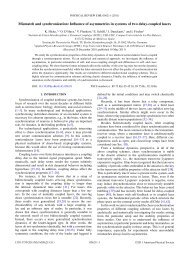DBI Analysis of Open String Bound States on Non-compact D-branes
DBI Analysis of Open String Bound States on Non-compact D-branes
DBI Analysis of Open String Bound States on Non-compact D-branes
You also want an ePaper? Increase the reach of your titles
YUMPU automatically turns print PDFs into web optimized ePapers that Google loves.
CHAPTER 5. BRANES 64meaning that the level-matching c<strong>on</strong>diti<strong>on</strong> got somewhat altered, and[ (K ) 2 ( ) ]WR2α ′ M 2 = α ′ +R α ′ + 2N L + 2N R − 4. (5.17)This last equati<strong>on</strong> hides a symmetry, namely it is invariant under the simultaneoustransformati<strong>on</strong>s {R −→ ˜R = α ′ R −1 ,(5.18)W ←→ K.This symmetry is exactly what is called T-duality, and it teaches us that for closedstrings <strong>compact</strong>ificati<strong>on</strong> <strong>on</strong> a circle <str<strong>on</strong>g>of</str<strong>on</strong>g> radius R is physically equivalent to, and evenindistinguishable from, <strong>compact</strong>ificati<strong>on</strong> <strong>on</strong> a circle <str<strong>on</strong>g>of</str<strong>on</strong>g> radius α ′ R −1 . You might w<strong>on</strong>derwhy it is called a duality and not a symmetry. The reas<strong>on</strong> is simple: it is <strong>on</strong>ly asymmetry in the closed string case, but not in the open string case as we will so<strong>on</strong> findout. However, we will still be able to map soluti<strong>on</strong>s <str<strong>on</strong>g>of</str<strong>on</strong>g> <strong>on</strong>e theory to soluti<strong>on</strong>s <str<strong>on</strong>g>of</str<strong>on</strong>g> another,hence we are left with a duality. According to [11] (p.38), the “T” stands for “targetspace,” being as we map different space-time c<strong>on</strong>figurati<strong>on</strong>s into <strong>on</strong>e another.At any rate, the effect <str<strong>on</strong>g>of</str<strong>on</strong>g> performing a T-duality transformati<strong>on</strong> <strong>on</strong> the closed stringalso entails that <strong>on</strong>e changesX 25R −→ −X 25R ; X 25L −→ X 25L . (5.19)This mapping is obvious for the zero modes, in which case it simply follows from Eqs.5.8 and 5.9, but for the other modes we need to impose this. We can do this, as thischanges nothing to the physics <str<strong>on</strong>g>of</str<strong>on</strong>g> our theory. This map leaves all physical quantities<str<strong>on</strong>g>of</str<strong>on</strong>g> the theory unchainged, and hence truely c<strong>on</strong>stitutes a symmetry. This allows <strong>on</strong>e toexpress the theory using an equivalent coordinate ˜X defined aswith the generic expansi<strong>on</strong>˜X 25 (σ, τ) = X 25L (τ + σ) − X 25R (τ − σ), (5.20)˜X 25 (σ, τ) = ˜x 25 + 2α ′K R σ + 2RWτ25 + oscillators. (5.21)We note that R can take <strong>on</strong> a specific value at which the theory is self-dual, namelyR = √ α ′ . At this radius, the massless closed string spectrum gets modified so as toacquire two SU(2) gauge groups, <strong>on</strong>e left-moving and <strong>on</strong>e right-moving. For a shortdiscussi<strong>on</strong>, see [12] §3.3.It is worth pointing out a major difference between Kaluza-Klein (KK) <strong>compact</strong>ificati<strong>on</strong>and T-duality. With KK <strong>compact</strong>ificati<strong>on</strong>, what <strong>on</strong>e does is <strong>compact</strong>ify adimensi<strong>on</strong>, so that <strong>on</strong>e can make it “disappear” by choosing it infinitally small (R −→ 0limit), in which case its physics decouple from that in the other dimensi<strong>on</strong>s. This ispossible, because in KK theory, <strong>on</strong>e <strong>on</strong>ly has a mass-squared-like factor going as ∼ R −2 .With T-duality however, two mass-squared-like terms appear, <strong>on</strong>e going as ∼ R −2 andanother going as ∼ R 2 . You simply cannot make them both disappear simultaneously!
















